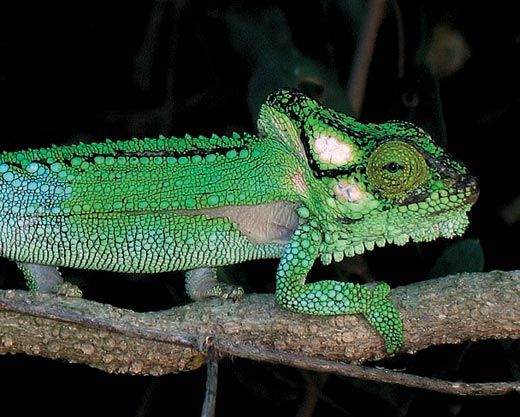Wild Things
Life as We Know It
/https://tf-cmsv2-smithsonianmag-media.s3.amazonaws.com/filer/wild_apr08_631.jpg)
Egged On
Look again—the arrow isn't pointing to a berry. It's a parasitic worm's way of getting around. Scientists at the Smithsonian Tropical Research Institute in Panama discovered the tiny nematode worm, whose eggs swell an ant's abdomen and turn it red. Such "fruit mimicry" tricks a berry-seeking bird into eating an infected ant and spreading the worm's eggs in its droppings, which ants eat—starting the cycle anew.
Follow the Leader
Chimpanzees eat mostly fruit, but now and then a group hunts down a monkey. What makes them attack? Leadership, according to a nine-year study of 14 adult male chimps in Uganda. Two of the males were most likely to hunt. Other chimps seldom went hunting unless one or both leaders participated, showing that a group decision can be catalyzed by an individual.
Observed
Name: Southern African dwarf chameleons (Bradypodion spp.)
Everybody Knows: Chameleons change color.
But Who Knew? They do it not just to hide, but to be seen.
How Do You Know? Researchers from Australia and South Africa
compared chameleons from 21 species and subspecies. In one test, the scientists placed pairs of males on a stick. The dominant male turned a bright color, while the other slinked away and faded. Some types of chameleons showed dramatic color differences, others less so. But the range of color didn't have much to do with the appearance of the chameleons' habitats. The researchers contend that communication is a more powerful force than camouflage in the evolution of chameleon color change.

Tell Tail
A male Anna's hummingbird courts females by flying up 100 feet, diving at 50 miles per hour and emitting a loud squeak. But where does the sound come from? Not its throat, say University of California at Berkeley researchers. High-speed video and wind-tunnel tests show it's the speeding bird's tail feathers that chirp, vibrating like a clarinet reed.
Time to Breed
If dinosaurs developed like birds, their closest living relatives, they would not have reached sexual maturity until full-grown. But a University of California at Berkeley study suggests the animals were precocious. Fossils of young allosaurus and tenontosaurus contained medullary bone, calcium-rich tissue for building eggshells during pregnancy. The researchers speculate that because dinosaurs tended not to reach a ripe old age, they had to live fast and breed young.